Optimizing merchandising processes is crucial for ensuring efficiency and customer satisfaction in competitive retail environment. One effective tool for process improvement is the SIPOC diagram, which provides a clear, high-level view of the key components involved in any process—Suppliers, Inputs, Processes, Outputs, and Customers. To create and collaborate on these diagrams, Boardmix offers an intuitive, cloud-based platform that allows teams to design, share, and refine their SIPOC diagrams in real-time. With its easy-to-use interface and customizable templates, Boardmix simplifies the process of optimizing merchandising workflows and improving overall performance.
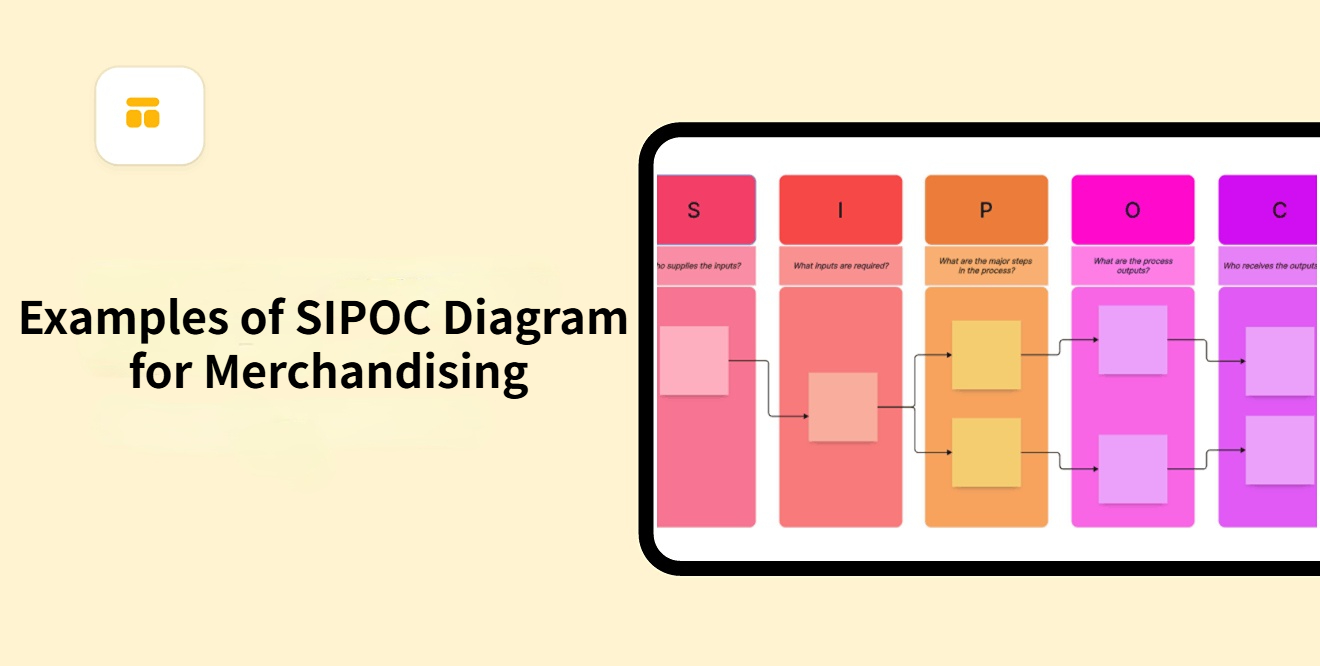
What is a SIPOC Diagram?
A SIPOC diagram is a visual tool used to map out the key components of a process. The acronym SIPOC stands for Suppliers, Inputs, Process, Outputs, and Customers. It helps to understand the flow of a process by identifying who provides the inputs, what inputs are needed, the steps involved in the process, what the outputs are, and who the customers are. SIPOC diagrams are commonly used in process improvement to highlight inefficiencies and areas for optimization, making it easier to analyze and improve the overall workflow. It’s especially useful in methodologies like Six Sigma or Lean.
Why is it Important to Use a SIPOC Diagram for Merchandising?
A SIPOC diagram is a powerful tool for process optimization in merchandising. It offers a clear overview of all components involved in a merchandising process, allowing businesses to identify inefficiencies and improve operations. Using SIPOC diagrams helps streamline workflows, enhance communication, and reduce errors. This clarity can ultimately lead to better decision-making and increased profitability.
By leveraging online whiteboard tools, teams can easily visualize and organize these components in one place. This results in enhanced productivity and a more organized merchandising strategy.
Who can Benefit from a SIPOC Diagram for Merchandising?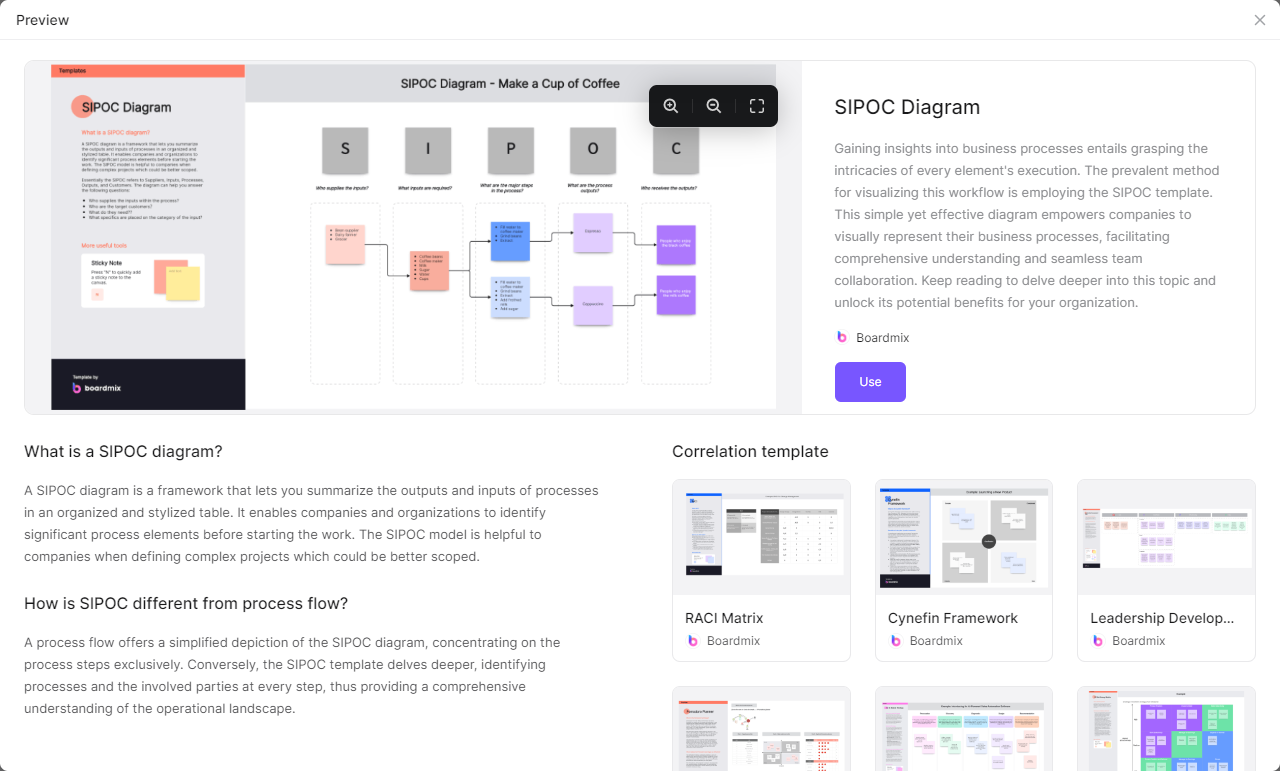
A SIPOC diagram for merchandising can benefit several key stakeholders involved in the merchandising process. Here’s a breakdown of who can gain from using SIPOC diagrams:
- Product Managers:
- Help visualize the entire product lifecycle, from suppliers to customers.
- Identify inefficiencies in sourcing, production, and distribution processes.
- Retail Managers:
- Streamline in-store operations and product placement strategies.
- Improve inventory management and ensure products are readily available for customers.
- Marketing Teams:
- Develop targeted promotions and advertising strategies based on clear insights from the SIPOC diagram.
- Understand customer needs and preferences more effectively to craft better campaigns.
- Suppliers:
- Align their production and delivery schedules with merchandising needs.
- Ensure that they are providing the right materials or products at the right time.
- Finance Teams:
- Understand the cost structure and flow of resources throughout the merchandising process.
- Make more informed budgeting and forecasting decisions based on process insights.
With whiteboard tools, all of these teams can collaborate in real-time, ensuring everyone is on the same page and working towards common objectives. This improves efficiency and enhances the overall effectiveness of merchandising strategies.
How to Create SIPOC Diagrams for Merchandising to Optimize Process?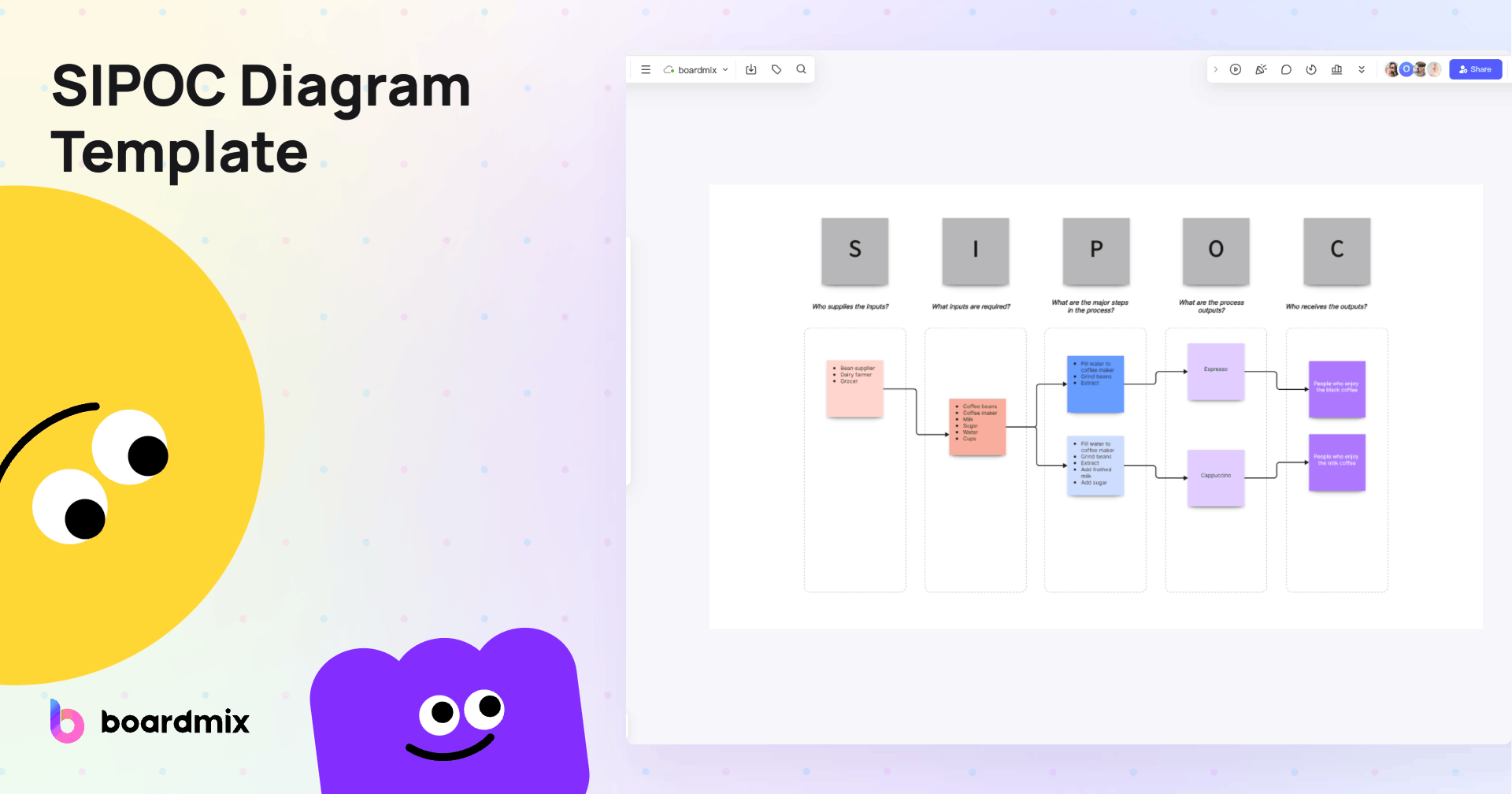
To effectively create SIPOC diagrams for merchandising and optimize your processes, using the right tools is essential. Boardmix offers a collaborative platform where you can easily map out and visualize the SIPOC components for any merchandising process. The following steps will guide you through creating a SIPOC diagram and utilizing it to improve your merchandising strategy, making the process smoother and more efficient.
Step 1: Log in to Boardmix
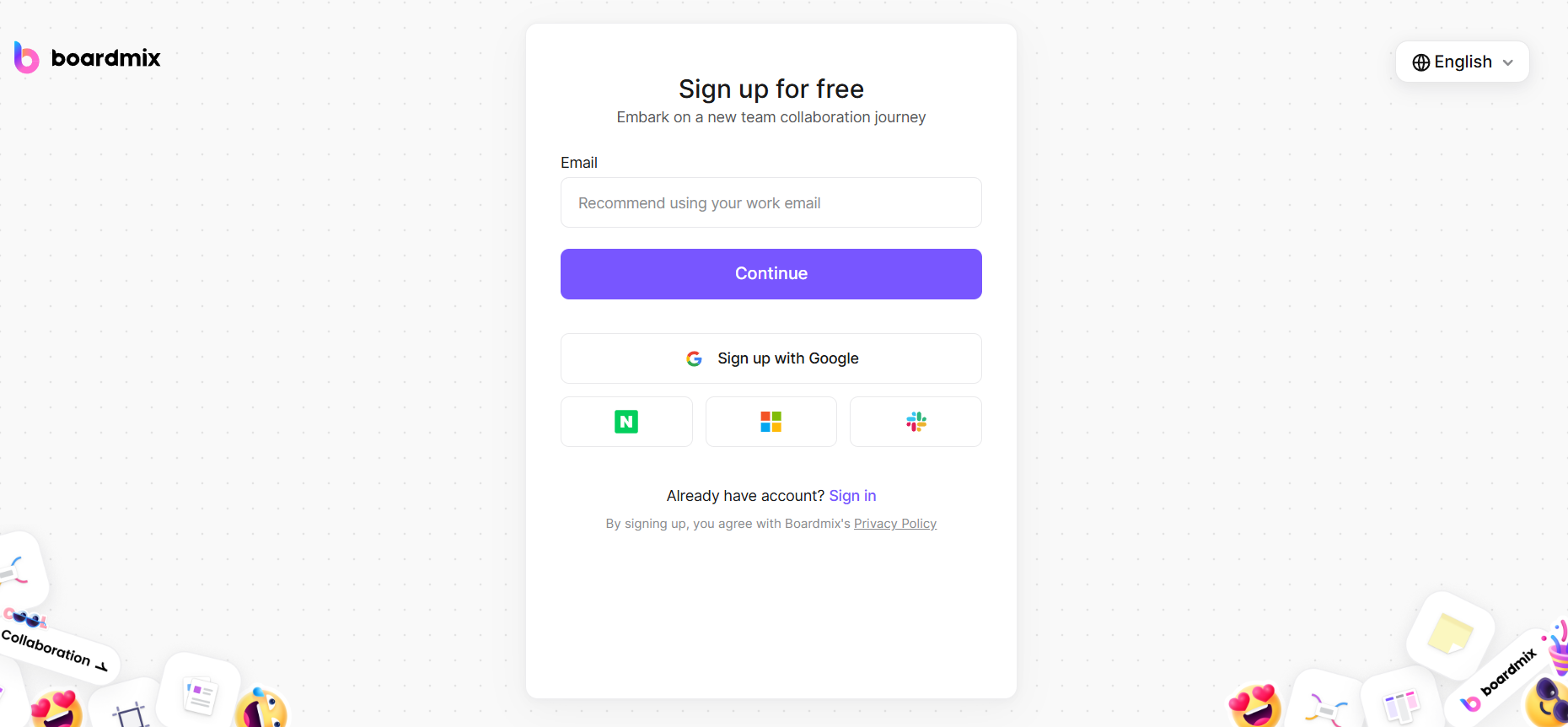
First, sign in to your Boardmix account. If you don't have an account, create one for free. Once you're logged in, you'll have access to the tools needed to create and collaborate on SIPOC diagrams. The platform offers an easy-to-use interface that ensures you can start quickly and efficiently.
Step 2: Access the Template Library
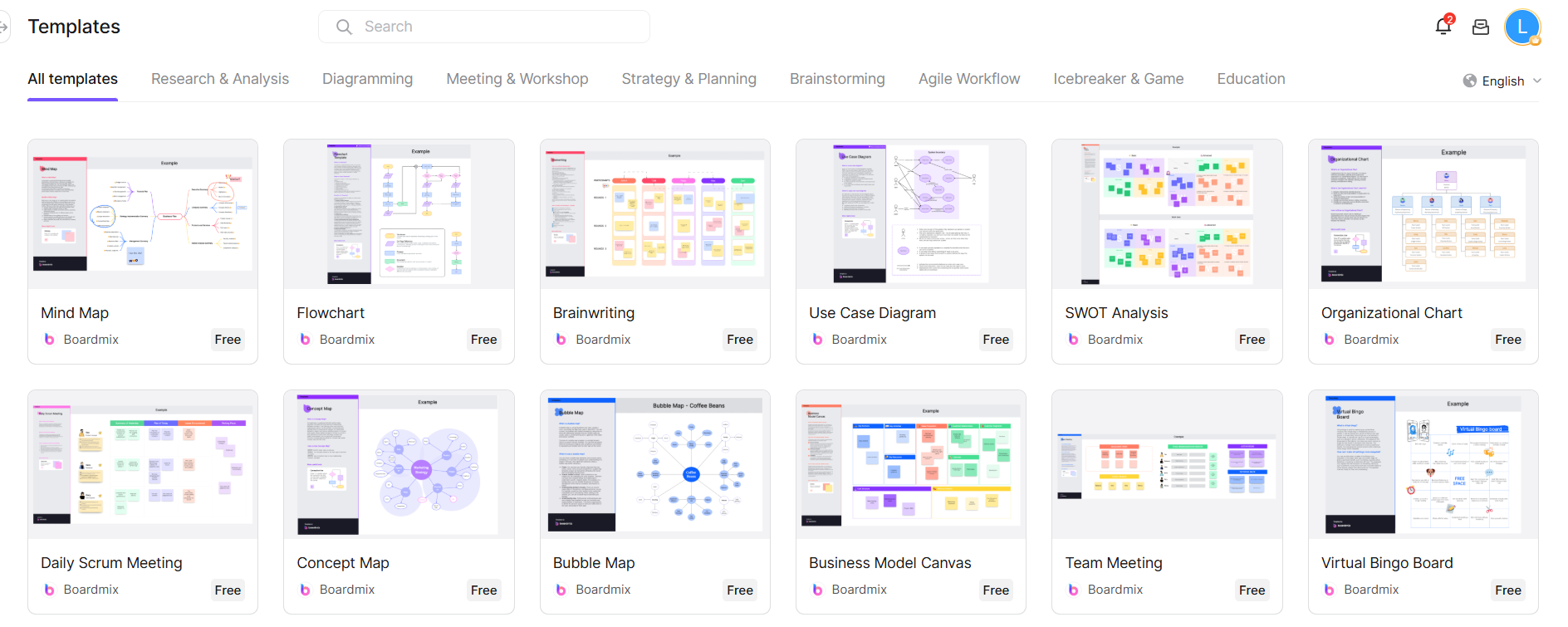
Next, go to the template library within Boardmix. You'll find pre-built templates for SIPOC diagrams, which are perfect for merchandising processes. Choose the SIPOC diagram template or start with a blank template if you prefer to design it from scratch.
Step 3: Define Your Process Components
Fill in the categories of your SIPOC diagram: Suppliers, Inputs, Process, Outputs, and Customers. Identify the suppliers providing the necessary materials or services, inputs required for the process, the steps involved in the process, the outputs produced, and the customers receiving the results.
Step 4: Collaborate with Your Team
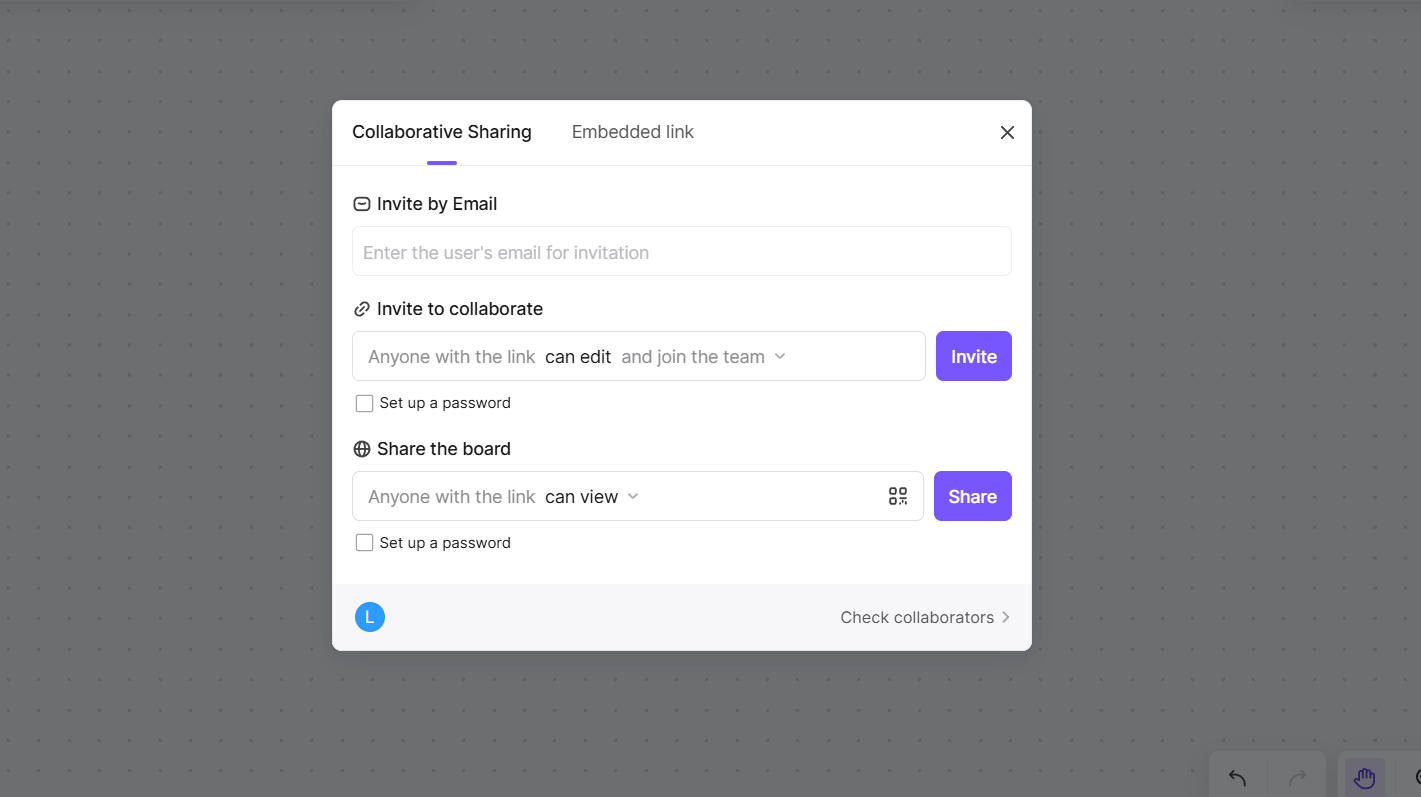
Once you've mapped out the SIPOC diagram, invite your team members to collaborate in real-time. Boardmix allows for seamless collaboration, so everyone can contribute their insights and make adjustments on the fly. This collaborative effort helps ensure that all components are accurately captured.
Step 5: Analyze and Optimize the Process
Review the completed SIPOC diagram with your team to identify inefficiencies and areas for improvement. Using Boardmix’s interactive features, you can make real-time adjustments, refine processes, and optimize the merchandising workflow to enhance overall productivity and customer satisfaction.
By following these steps, you can efficiently create a SIPOC diagram for your merchandising process using Boardmix. This tool helps you visualize each step, collaborate with your team, and identify areas for improvement. With Boardmix, you can optimize your process and enhance overall efficiency in no time.
6 Examples of SIPOC Diagrams for Merchandising
- SIPOC Diagram for Merchandising - Basic Example
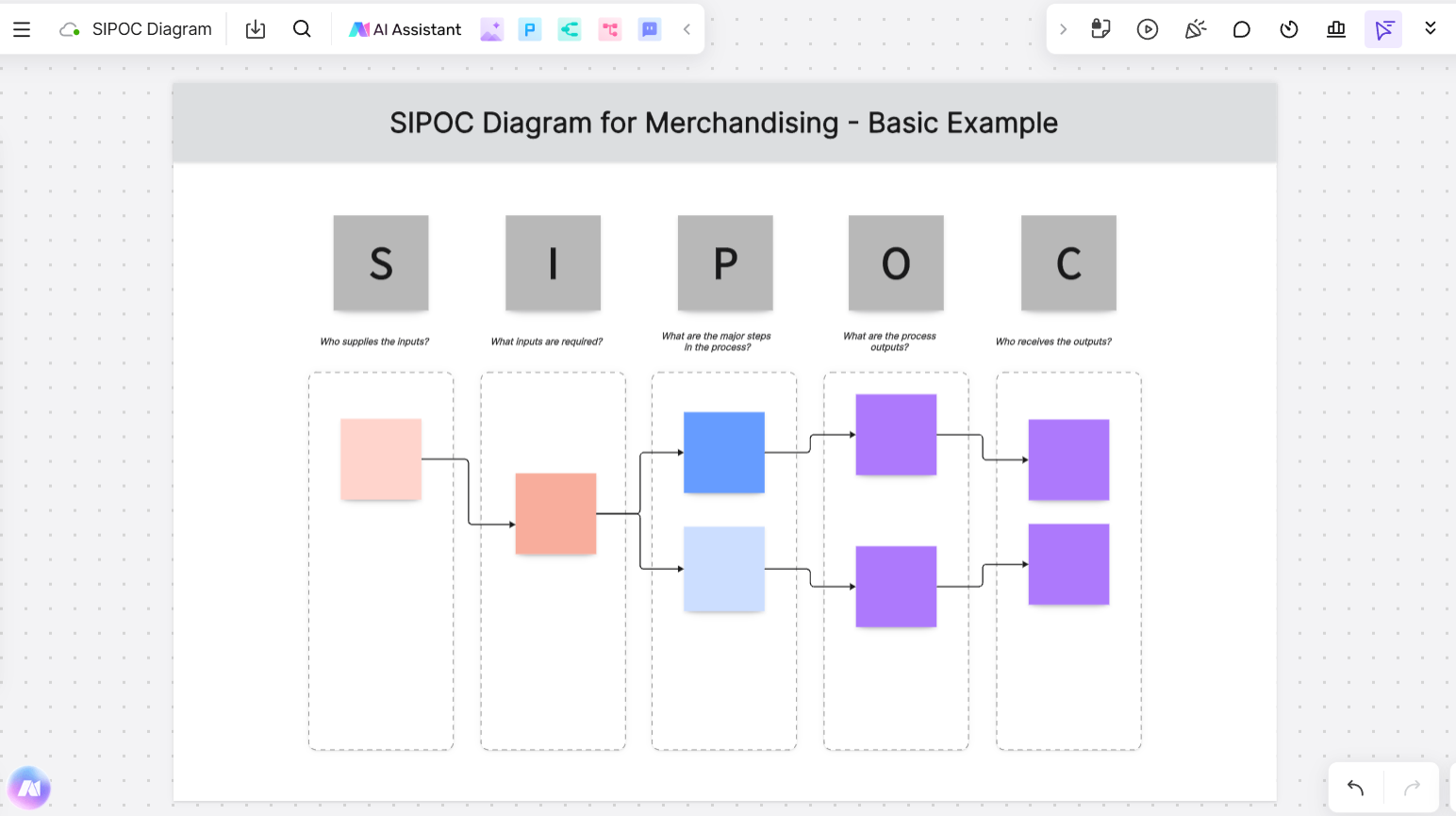
- Supply: Suppliers of raw materials.
- Input: Design specifications, production schedules, inventory data.
- Process: Manufacturing, quality checks, and distribution of products.
- Output: Finished products, packaged goods ready for retail.
- Customer: Retailers or stores that sell the products to end customers.
This basic SIPOC example helps visualize the overall flow from raw materials to customers, allowing businesses to pinpoint inefficiencies in production or distribution.
- SIPOC Diagram for Merchandising - Pricing Strategy
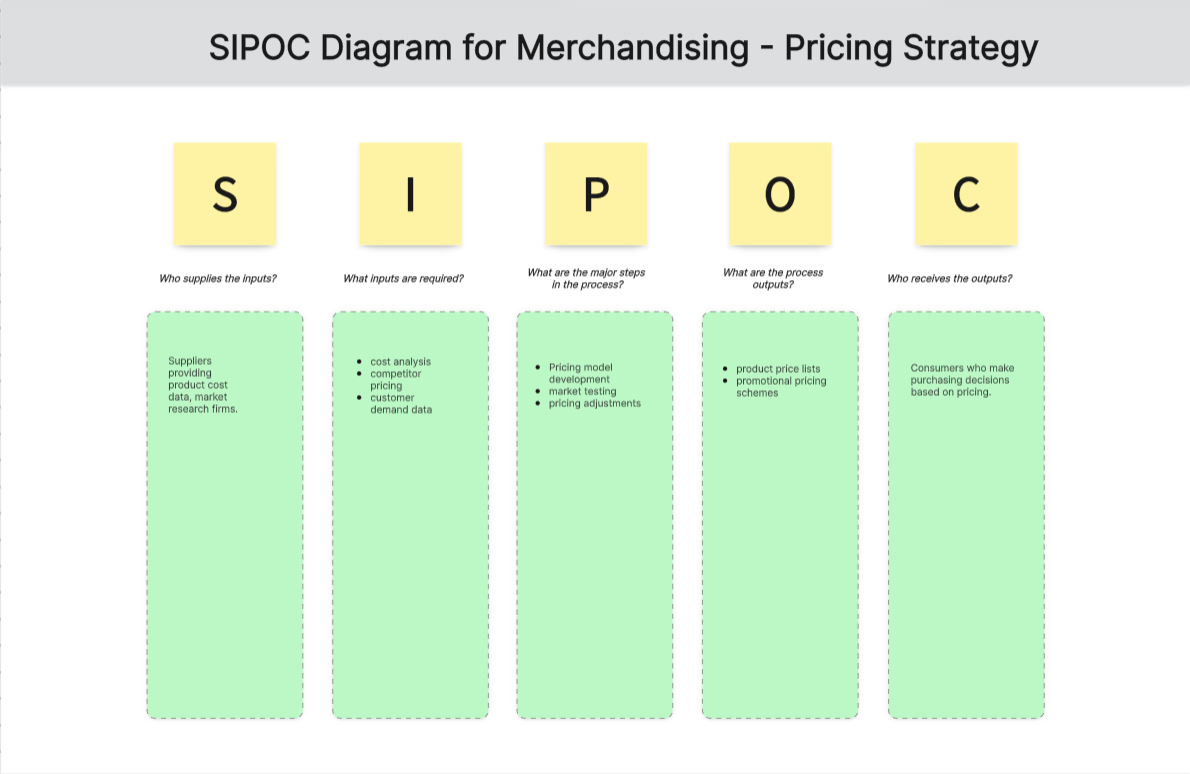
- Supply: Suppliers providing product cost data, market research firms.
- Input: Cost analysis, competitor pricing, customer demand data.
- Process: Pricing model development, market testing, pricing adjustments.
- Output: Product price lists, promotional pricing schemes.
- Customer: Consumers who make purchasing decisions based on pricing.
This SIPOC diagram helps marketing and sales teams optimize pricing strategies by ensuring all inputs are aligned with business goals and customer expectations.
- SIPOC Diagram for Merchandising - Sales Promotions

- Supply: Suppliers of promotional materials, digital platforms.
- Input: Promotional concepts, budget, discount structures.
- Process: Designing and launching promotions (e.g., online campaigns, in-store events).
- Output: Promotional offers, special discounts, ads.
- Customer: Shoppers or potential buyers who engage with the promotions.
Sales teams can benefit from this SIPOC diagram by identifying the most effective promotional strategies and ensuring timely execution of marketing campaigns.
- SIPOC Diagram for Merchandising - Product Display Optimization
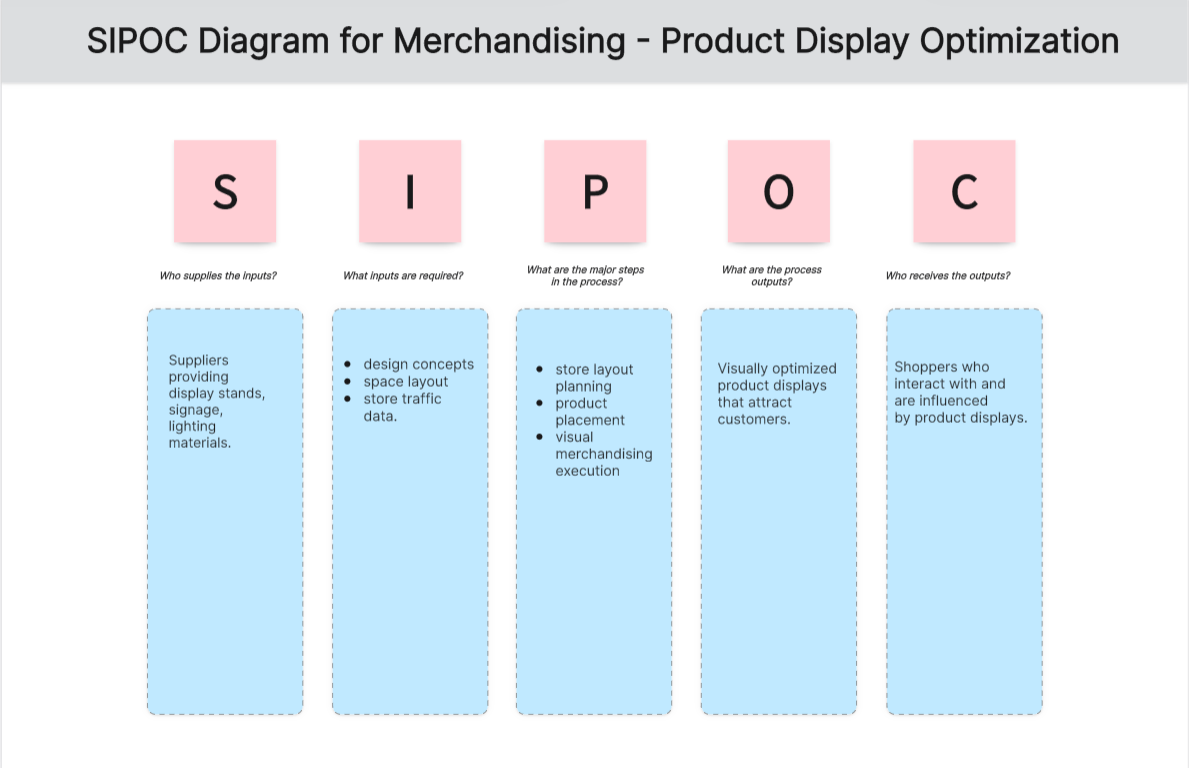
- Supply: Suppliers providing display stands, signage, lighting materials.
- Input: Design concepts, space layout, store traffic data.
- Process: Store layout planning, product placement, and visual merchandising execution.
- Output: Visually optimized product displays that attract customers.
- Customer: Shoppers who interact with and are influenced by product displays.
This diagram helps retail managers improve the aesthetics and functionality of store displays, leading to better customer engagement and sales performance.
- SIPOC Diagram for Merchandising - Seasonal Product Promotions

- Supply: Suppliers of seasonal products (e.g., winter apparel, holiday decorations).
- Input: Seasonal product trends, customer insights, promotional calendars.
- Process: Developing seasonal promotions, in-store and online advertisements.
- Output: Seasonal offers, limited-time discounts, holiday-themed products.
- Customer: Customers seeking seasonal products or gifts.
Seasonal SIPOC diagrams ensure businesses optimize their timing and offerings, capturing customer interest during peak periods like holidays and special events.
- SIPOC Diagram for Merchandising - Product Inventory Management
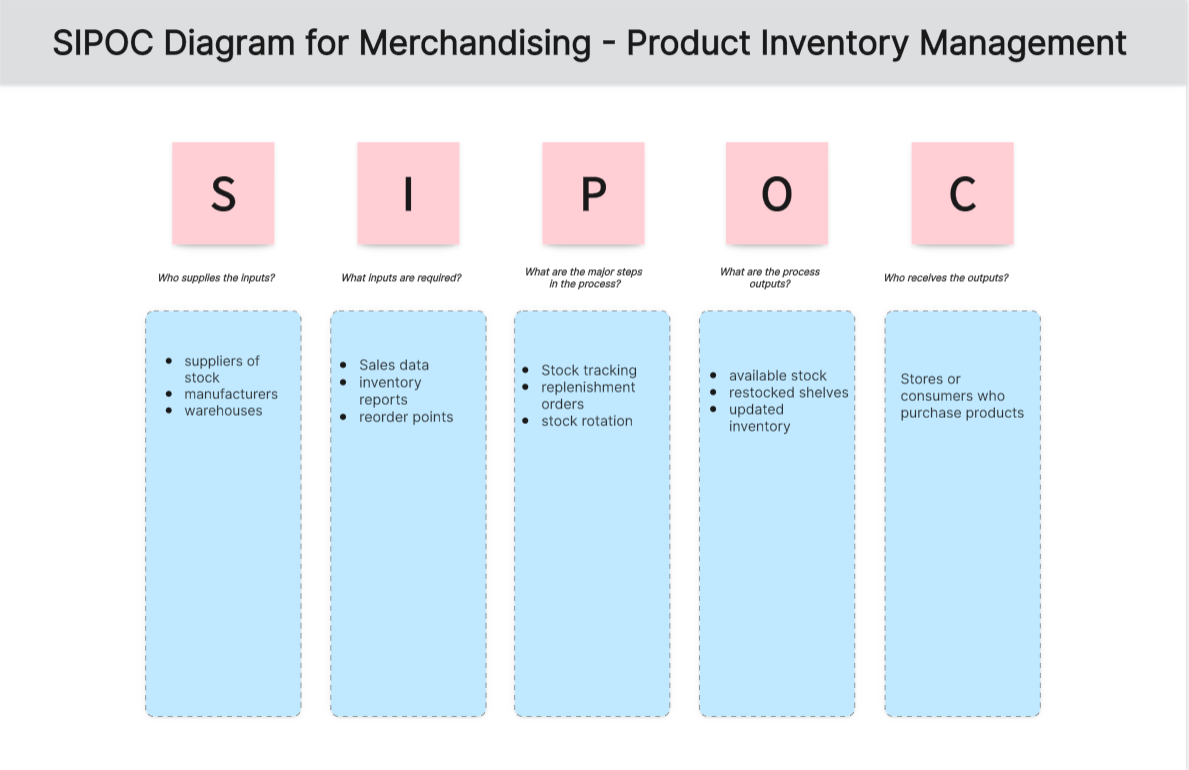
- Supply: Suppliers of stock, manufacturers, warehouses.
- Input: Sales data, inventory reports, reorder points.
- Process: Stock tracking, replenishment orders, stock rotation.
- Output: Available stock, restocked shelves, updated inventory.
- Customer: Stores or consumers who purchase products.
By using this SIPOC diagram, inventory managers can ensure product availability and avoid stockouts, improving overall operational efficiency and customer satisfaction.
The Bottom Line
SIPOC diagrams for merchandising are invaluable tools that help optimize processes, improve communication, and increase operational efficiency. By creating clear visual representations of each step in the merchandising process, businesses can identify inefficiencies and streamline operations. Boardmix make it easier to create, update, and collaborate on SIPOC diagrams, ensuring better results across various aspects of merchandising.









